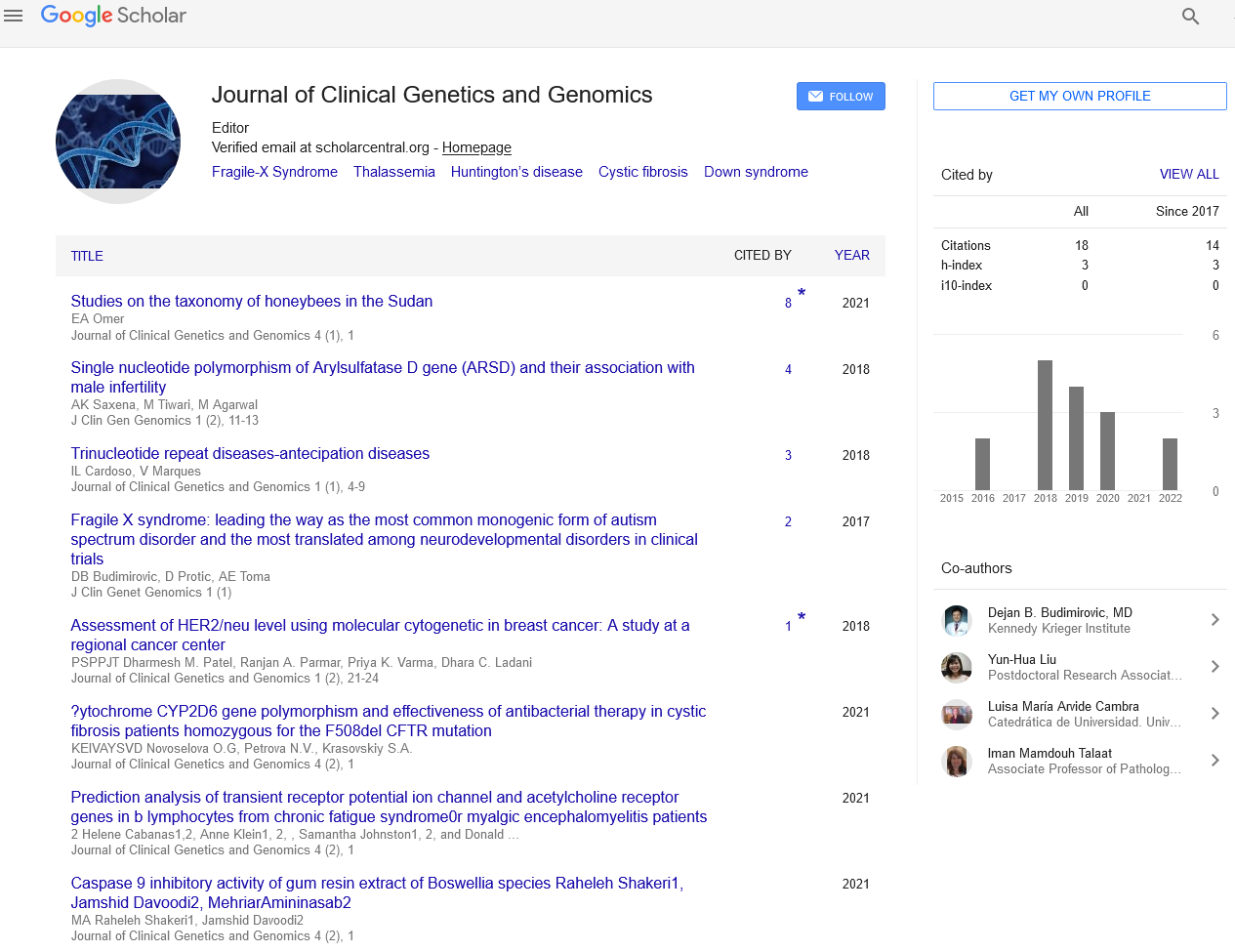Rare diseases: power in numbers
Received: 26-Feb-2018 Accepted Date: Feb 26, 2018; Published: 28-Feb-2018
This open-access article is distributed under the terms of the Creative Commons Attribution Non-Commercial License (CC BY-NC) (http://creativecommons.org/licenses/by-nc/4.0/), which permits reuse, distribution and reproduction of the article, provided that the original work is properly cited and the reuse is restricted to noncommercial purposes. For commercial reuse, contact reprints@pulsus.com
Genetics is an area of biology that focuses on the study of heredity and the investigation of inherited characteristics. In the past twenty years, initiatives such as the Human Genome Project have enabled us to amass great knowledge on the relationships between genes, mutations and the molecular pathways that are involved in disease diagnosis and prognosis. Nevertheless, there are still a number of diseases that are either misdiagnosed or for which no genetic diagnosis exists, adding stress to the lives of patients and their families. Some of these diseases and disorders are rare, affecting less than 1 in 2,000 individuals, resulting in perhaps diminished interest in finding an effective cure for them.
The official definition of a rare disease is a disease that affects less than 1 in 2,000 individuals in Europe or fewer than 200,000 Americans at any given time. Overall, there are more than 6,000 rare diseases that may involve either a handful of individuals or over 200,000 patients. Around 80% of these diseases have a known genetic origin, resulting from mutations in one or more genes, while others arise as a consequence of genetic and environmental interactions, bacterial and viral infections or due to unknown causes. Significantly, over 50% of rare diseases have pediatric manifestations affecting individuals from the early days of their lives. Importantly, rare diseases are frequently mis-diagnosed, either due to lack of expert knowledge or because of the similarity in symptoms between the various conditions. The fact that rare diseases display a range of symptoms and variable severity, even between closely related individuals, adds further complexity to correct diagnosis. In addition, access to treatment and care can be limited, tricky or even non-existent.
One such rare disease that has variable manifestation and affects children from as early as in utero is Autosomal Recessive Polycystic Kidney Disease (ARPKD). ARPKD is a rare, genetically inherited condition found in 1 in 20,000 to 1 in 40,000 children and young adults and is a common cause of perinatal death. Severe ARPKD manifestation is detected as bilaterally enlarged, cystic kidneys in utero, kidney abnormalities and lung hypoplasia, together with low or no amniotic fluid. More moderate manifestation of ARPKD is diagnosed around or after birth, where the children might be premature, have problems with their salt and water balance and display poor lung development and renal insufficiency. On the other hand, mild ARPKD is characterised by poor kidney function, hypertension, cholangitis and urinary tract infections and it is detected later on in life. Irrespective of the age of diagnosis, there is no pharmacological treatment for ARPKD; instead, clinicians concentrate on managing the symptoms. Interventions depend on the age of diagnosis and range from amniotic fluid replacement, ventilation after birth and medical treatment for hypertension to kidney dialysis and ultimately kidney and/or liver transplantation, when the patients lose organ function.
ARPKD is caused by mutations in Polycystic Kidney and Hepatic Disease 1 (PKHD1), the gene encoding fibrocystin/polyductin. Mutations have been found throughout the whole PKHD1 gene sequence and it has been reported that the combinations of mutations affect ARPKD severity. Patients with missense mutations are compatible with life, whereas the presence of two truncating mutations results in a lethal outcome. T36M remains the most common mutation to date, detected in about 10% of ARPKD patients. Fibrocystin, the protein that PKHD1 encodes, is a ~450 kDa membrane-associated receptor-like protein, with a large N-terminal domain, a single transmembrane domain and a short intracellular Cterminal domain. It is a developmentally regulated protein that is required for normal kidney development and it is expressed amongst other places on a characteristic cellular organelle called the primary cilium. Interestingly, it has now been shown that other genes that interact with PKHD1 can also impact ARPKD severity. It is thus important to shed more light on this network of interactions and understand the molecular mechanisms that influence disease manifestation.
One initiative which will significantly assist in better understanding of ARPKD is ARegPKD, the European registry involving more than 400 patients from over 20 countries that represent a significant ARPKD cohort. The aim of this registry is to generate detailed information and data on these patients, in order to contribute to the pathophysiological understanding of ARPKD and improve its clinical management.
Further assistance with gaining a detailed insight into the study of rare diseases is also provided by initiatives such as the 100,000 Genomes project, which aims to sequence the genomes of 70,000 people in the UK that suffer either from a rare disease or cancer, in order to offer personalised diagnosis and novel, effective treatments. So far, 50% of the genomic sequencing has been completed, empowering patients with an accurate, genetic diagnosis of their condition. In this direction, EURORDIS, the voice of Rare Disease patients in Europe organises Rare Disease day on the last day of February each year. The aim of the day is to inform the general public and decision makers about the impact of rare diseases in patients’ lives, in order to improve knowledge, encourage research and address the needs of people living with rare diseases. 94 countries are currently taking part in this campaign, with events happening in hundreds of cities across the globe. It is thus crucial that 28th February 2018 will be another memorable day for anyone suffering from a Rare Disease, ultimately impacting on disease diagnosis, prognosis and treatment.





